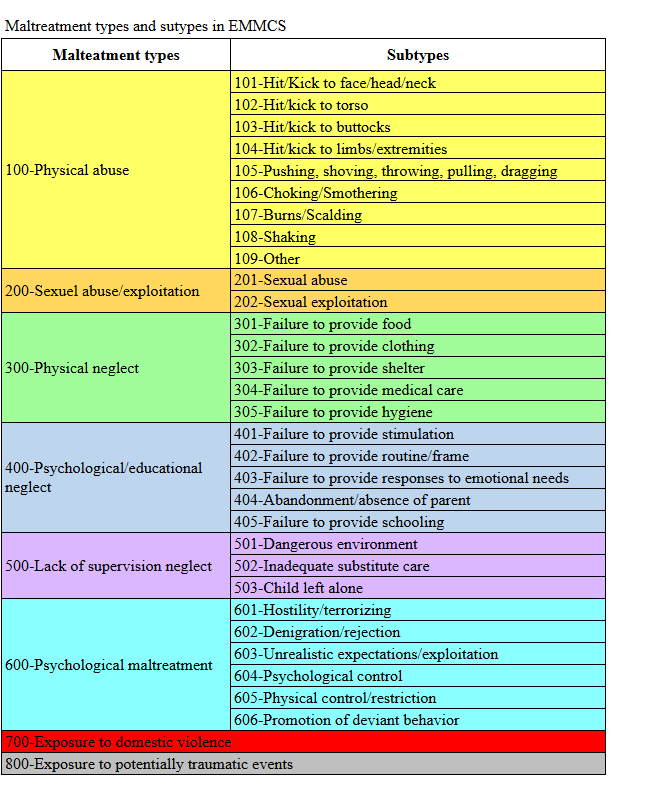Extended Modified Maltreatment Classification System (EMMCS)
The Extended Modified Maltreatment Classification System (EMMCS) is a coding grid that allows for the standardized extraction of different variables concerning the main dimensions of maltreatment (types of maltreatment suffered by the child, severity, frequency, chronicity) from narrative investigation reports from child protective services (CPS) workers. The main advantage of this instrument is that it allows for the documentation of maltreatment in much more detail than extracting CPS administrative data. The disadvantage is that it requires a significant investment of time to learn how to use the instrument and then to code the files.
The EMMCS is an updated version (produced by Sébastien Monette) of the Modified Maltreatment Classification System (MMCS; English et al., 1997). The MMCS has been used in more than 75 studies (Huffhines et al., 2016) and is considered the most complete instrument for coding the narrative report assessments produced by CPS caseworkers (Jackson et al., 2019). The main difference between the MMCS and the EMMCS is the addition of several subtypes of psychological maltreatment.
Whereas the MMCS has only one global psychological maltreatment category and no codes for specific subtypes, the EMMCS breaks this category down into several subtypes (see below). The EMMCS also covers dimensions of maltreatment derived from the LONGSCAN study (see the special issue of Child Abuse and Neglect in 2005), such as chronicity. Our team is presently testing and validating this instrument.
The EMMCS comprises the following variables:
1) Types and subtypes of maltreatment:
The EMMCS includes 8 types of maltreatment and several subtypes, as illustrated in the following table:

2) Severity. The EMMCS also allows rating each coded maltreatment event for severity on a Likert scale from 1 to 5. The final severity variables are maximum severity per maltreatment subtype, as recommended in previous studies (Litrownik et al., 2005);
3) Frequency. The EMMCS allows measuring number of events by subtype;
4) Periods of exposure. The EMMCS measures the periods of exposure to maltreatment according to the four developmental stages (0 to 1½ years, 1½ to 3 years, 3 to 6 years, 6 to 12 years) identified in English, Graham, et al. (2005) and we added a fifth period (12-17 years);
5) Chronicity. A maltreatment chronicity score (1 to 5) is given as a function of the number of developmental periods of exposure to maltreatment and of the contiguity of these periods (see English, Graham, et al., 2005). Other modules have also been added covering parent risk factors (e.g., substance abuse, mental health problems, intellectual disability) and child adverse life event risk factors (e.g., exposure to drugs or alcohol during pregnancy, loss of a caregiver, accidents or serious illness).
The EMMCS manual includes the following sections:
- 1) Introduction
- 2) Instrument Update
- 3) General Coding Principles
- 4) Maltreatment Codes
- 5) Parental Risk Factor Codes
- 6) Child’s Adverse Life Events Codes
- 7) References
- 8) Useful SPSS Syntaxes
- Appendix 1: EMMCS Form
- Appendix 2: Example of a Completed Form and a Coded Child Record
- Appendix 3: Summary of EMMCS Severity Codes by Maltreatment Subtype (print in 11 x 17-inch format)
A validation study (Monette et al., 2025) conducted on 240 child files reported to the Child protective services showed excellent inter-rater agreements on the EMMCS for all the variables generated by the tool: maximum severity by type and subtype of maltreatment (mean intra-class correlation = .91), frequency of events by type and subtype of maltreatment (mean intra-class correlation = .91), developmental period of exposure (mean kappa = .98), other adverse life events of the child (mean kappa = .90) and parental risk factors of the mother and father (mean kappa = .99 and .91, respectively). The tool also shows a good level of narrow convergent validity, as indicated by a mean kappa of .66 for the presence of types of maltreatment, as measured by another similar, but less detailed, tool. The tool finally shows a good level of extended convergent validity with indicators of child psychopathology, for example, specific correlations between: a) indicators (combined frequency and maximum severity) of sexual abuse on the EMMCS and the presence of problematic sexual behaviors in the child; b) indicators of physical and psychological neglect on the EMMCS and the presence of attachment issues and developmental delay in the child and c) indicators of psychological maltreatment on the EMMCS and the presence of externalizing and internalizing behaviors in the child.
